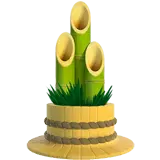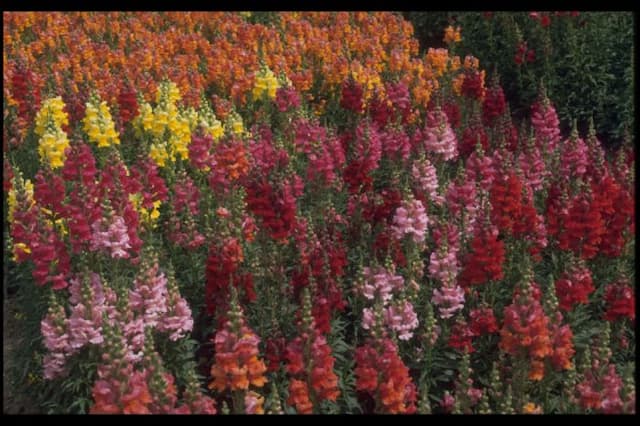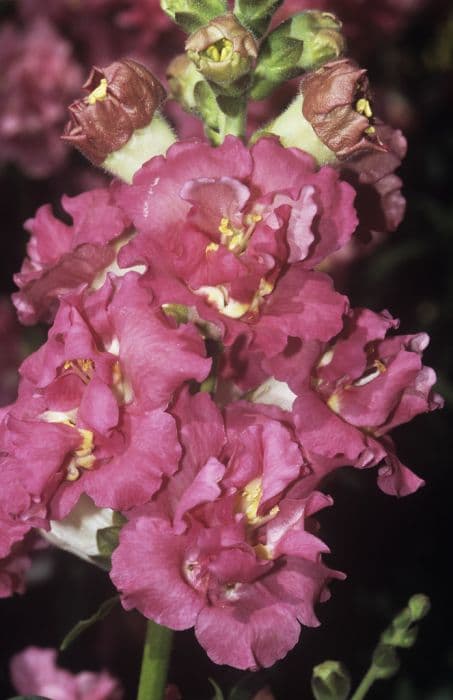Yellow Foxglove Digitalis lutea

ABOUT
Digitalis lutea, commonly known as the straw foxglove, is a perennial plant known for its distinctive and captivating flower display. The plant is characterized by a rosette of downy, oblong leaves that form at its base, providing a lush, green backdrop for its blooms. From the center of this leafy base emerges a spike that bears numerous, small, bell-shaped flowers. Each flower delicately hangs like a little bell or lantern from the stem. The blooms of the straw foxglove are a soft, pale yellow, almost cream-like in color, providing a subtle yet enchanting visual appeal which stands out amidst the darker greens in a garden setting. The inside surface of the flowers is often speckled with brown or orange spots, adding to their ornate look. After flowering, the plant produces small, capsule-shaped seed pods that split open to release numerous tiny seeds. The plant's overall aspect is one of elegance and cottage-style charm, with foliage that remains relatively low to the ground, while its flowers gracefully reach upwards. The straw foxglove's modest and pastel-hued blossoms contribute to a dreamy aesthetic, making it a beloved addition to ornamental gardens, borders, and woodlands gardens where it can grow in partly shaded to fully sunny locations.
About this plant
 Names
NamesFamily
Plantaginaceae
Synonyms
Straw Foxglove, Small Yellow Foxglove, Yellow Foxglove
Common names
Digitalis eriostachya, Digitalis laevigata, Digitalis lutea subsp. australis, Digitalis lutea var. australis, Digitalis minor, Digitalis sulfurea
 Toxicity
ToxicityTo humans
The plant Digitalis lutea, commonly known as Yellow foxglove, contains cardiac glycosides which are toxic to humans if ingested. The toxicity can cause a range of symptoms such as nausea, vomiting, diarrhea, headaches, weakness, dizziness, palpitations, and possibly even seizures. In severe cases, ingestion can lead to cardiac arrhythmias and other heart-related complications which could be life-threatening. Immediate medical attention is necessary if ingestion is suspected.
To pets
Yellow foxglove, or Digitalis lutea, is toxic to pets due to its content of cardiac glycosides. If a pet ingests this plant, they may exhibit symptoms like vomiting, diarrhea, abdominal pain, cardiac arrhythmias, weakness, and possibly seizures. The severity of the toxicity can vary depending on the amount ingested and the size of the pet, but it can be fatal if not treated promptly. Urgent veterinary care is essential if a pet is suspected to have ingested any part of this plant.
 Characteristics
CharacteristicsLife cycle
Biennials
Foliage type
Deciduous
Color of leaves
Green
Flower color
Yellow
Height
2 feet (60 cm)
Spread
1 foot (30 cm)
Plant type
Herb
Hardiness zones
4
Native area
Europe
Benefits
 General Benefits
General Benefits- Attracts Pollinators: Digitalis lutea, also known as Yellow Foxglove, invites bees and other pollinating insects to the garden, helping to maintain biodiversity.
- Ornamental Value: With its tall spikes of tubular yellow flowers, it adds a vertical element and visual interest to garden design.
- Low Maintenance: Once established, it requires minimal care — it can tolerate partial shade and is relatively drought-resistant.
- Wildlife Habitat: Provides shelter and nesting opportunities for small beneficial insects and birds.
- Cottage Garden Appeal: Its traditional appearance makes it ideal for cottage-style gardens.
- Resists Deer: Digitalis lutea is not a favored plant of deer, so it's less likely to be damaged in areas with deer populations.
- Self-Seeding: It can self-seed under the right conditions, providing new plants for the next season without additional cost or effort.
 Medical Properties
Medical Properties- Cardiac glycosides: The leaves of Digitalis lutea contain compounds that can affect heart function.
- Positive inotropic effect: The plant has been traditionally used for its ability to increase the force of heart contractions.
- Antiarrhythmic effects: Digitalis lutea can be used to restore normal heart rhythm and treat certain types of cardiac arrhythmias.
 Air-purifying Qualities
Air-purifying QualitiesThis plant is not specifically known for air purifying qualities.
 Other Uses
Other Uses- Digitalis lutea, commonly known as the straw foxglove, can be used as a dye plant, providing various shades of yellow to fabrics.
- In gardening, the plant's tall and striking flowers can be used to add vertical interest in perennial borders.
- Because of its toxicity, straw foxglove can be used as a natural pest deterrent in gardens to protect other plants.
- The flowers of the straw foxglove are sometimes used in the composition of floral arrangements for their unique shape and color.
- Straw foxglove is occasionally utilized in educational settings, such as botany programs, to study plant ecology and pollination biology.
- The plant has historical use in folk magic and rituals, thought to protect against negative forces and evil spirits.
- Enthusiasts of straw foxglove may engage in photography or botanical art that focuses on capturing the beauty of this and other Digitalis species.
- As a cautionary exhibit, it may be included in poison gardens, which are collections of toxic plants grown for educational purposes.
- Deadheading the spent flowers can encourage the plant to produce more blooms and is practiced by some gardeners for extended visual enjoyment.
- The structural form of straw foxglove's leaves and flowers can be used as an inspiration for designers and architects in biomimetic applications.
Interesting Facts
 Feng Shui
Feng ShuiThe plant Foxglove is not used in Feng Shui practice.
 Zodiac Sign Compitability
Zodiac Sign CompitabilityThe plant Foxglove is not used in astrology practice.
 Plant Symbolism
Plant Symbolism- Healing: Digitalis lutea, commonly known as Yellow Foxglove, contains digitalin, a compound used in heart medications, symbolizing its healing properties.
- Bewitchment: The intoxicating nature of Yellow Foxglove's beauty and its toxic qualities have historically linked it to magic and enchantment.
- Insincerity: Due to its poisonous attributes, in floriography, or the language of flowers, Yellow Foxglove is sometimes associated with deceit or false sentiments.
- Protection: Folklore suggests planting Yellow Foxglove can protect from negative forces and ward off evil spirits.
 Water
WaterThe Straw Foxglove should be watered moderately, maintaining moist but well-drained soil conditions. During the growing season, generally from spring to fall, watering should occur once or twice a week, depending on weather conditions, with about 1-2 gallons each time for outdoor plants. In hot and dry periods, the frequency may need to increase to prevent the soil from drying out. During winter, reduce watering to once every few weeks, just enough to prevent the soil from completely drying out. Always check the top inch of the soil for dryness before watering again.
 Light
LightThe Straw Foxglove thrives in full sun to partial shade. It is best situated in a location that receives morning sunlight and is shaded during the hottest part of the day, especially in warmer climates. A spot that provides at least 4 to 6 hours of direct sunlight with some afternoon dappled shade or light shade is ideal for optimal growth.
 Temperature
TemperatureThe Straw Foxglove is hardy and can tolerate a temperature range from approximately 40°F to the low 80s°F. It prefers cooler climates and may struggle in temperatures exceeding 85°F. Ideally, keeping the plant in an environment where the average temperature is between 50°F and 70°F will encourage healthy growth and flowering. It can survive light frosts but should be protected from severe cold below 35°F.
 Pruning
PruningThe Straw Foxglove should be pruned to remove spent flower spikes and encourage a second bloom. Deadheading, or cutting back the faded flower stems just above the second set of leaves, can be done in late summer or as the flowers fade. Additionally, any damaged or dead foliage should be removed to keep the plant healthy. Pruning is usually not required in winter except for the removal of old foliage before spring growth.
 Cleaning
CleaningAs needed
 Soil
SoilThe best soil mix for the common plant 'Straw Foxglove' (Digitalis lutea) is well-draining and rich in organic matter. A mixture comprising equal parts of loam, peat, and sand can create an ideal growing environment; this plant thrives in a soil pH ranging from 6.0 to 7.5, preferring slightly acidic to neutral soil conditions.
 Repotting
RepottingStraw Foxglove, or Digitalis lutea, is a perennial plant that typically doesn't require frequent repotting. It can often be left undisturbed for several years. It is generally best to repot only when the plant has outgrown its current container or the soil has become depleted, usually every 2-3 years.
 Humidity & Misting
Humidity & MistingStraw Foxglove (Digitalis lutea) prefers moderate humidity but can tolerate the humidity levels typical of outdoor environments. If grown indoors, ensure that the air isn’t too dry, aiming for a humidity level close to 40-50%.
 Suitable locations
Suitable locationsIndoor
Place Straw Foxglove in bright, indirect light and well-draining soil.
Outdoor
Choose partial shade location and moist, well-drained soil for Straw Foxglove.
Hardiness zone
4-8 USDA
 Life cycle
Life cycleDigitalis lutea, commonly known as Straw Foxglove, begins its life cycle as a seed, which after dispersing from the parent plant, germinates typically in spring if conditions are favorable. The seedling stage is characterized by the emergence of a rosette of basal leaves that serves as the vegetative growth phase. In the subsequent year or years depending on environmental conditions, the plant enters the flowering stage, producing a spike of yellow tubular flowers that are attractive to pollinators such as bees. After pollination, these flowers develop into seed capsules containing numerous small seeds. Once the seeds mature, the capsules open and the seeds are spread by wind or gravity. The parent plant typically dies after seed production, completing the life cycle, although some plants may survive for multiple seasons if they do not flower and set seed immediately.
 Propogation
PropogationPropogation time
Spring-Summer
Propogation: The most popular method of propagating Digitalis lutea, commonly known as the Straw Foxglove, is through seed sowing. Propagation is typically done in late spring or early summer. To propagate by seeds, surface sow them on a well-draining seed starting mix, as they require light for germination. Covering the seeds with a light dusting of soil can help retain moisture. Keep the soil consistently moist but not waterlogged, and at a temperature of approximately 65 to 70 degrees Fahrenheit (18 to 21 degrees Celsius). Germination should occur in 2 to 4 weeks. Seedlings can then be transplanted outdoors after the risk of frost has passed, spacing them about a foot (30 centimeters) apart to allow adequate room for growth.





![Snapdragon [Pretty in Pink]](/_next/image?url=https%3A%2F%2Fplants-admin.emdemapps.com%2Fimages%2Fplants%2F%2Fimages%2F604b5cb3b5385.png&w=640&q=75)



